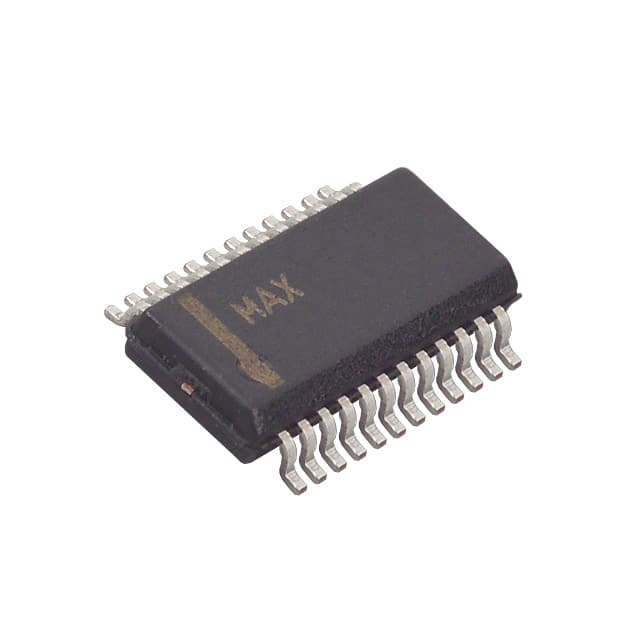MAX11633EEG+ - English Editing Encyclopedia Entry
Product Overview
- Category: Integrated Circuit (IC)
- Use: Analog-to-Digital Converter (ADC)
- Characteristics: High-resolution, low-power consumption
- Package: 24-pin SSOP package
- Essence: Converts analog signals into digital data
- Packaging/Quantity: Available in reels of 2500 units
Specifications
- Resolution: 16 bits
- Sampling Rate: Up to 200 kSPS (kilo samples per second)
- Input Voltage Range: 0V to VREF
- Power Supply: 2.7V to 3.6V
- Operating Temperature Range: -40°C to +85°C
Pin Configuration
The MAX11633EEG+ has a total of 24 pins. The pin configuration is as follows:
- IN0+ (Positive input for Channel 0)
- IN0- (Negative input for Channel 0)
- REF+ (Positive reference voltage input)
- REF- (Negative reference voltage input)
- AGND (Analog ground)
- VDD (Power supply)
- CS (Chip select)
- SCLK (Serial clock input)
- SDATA (Serial data output)
- EOC (End of conversion)
- DGND (Digital ground) 12-24. Reserved
Functional Features
- High-resolution ADC with 16-bit resolution
- Low-power consumption for energy-efficient applications
- Serial interface for easy integration with microcontrollers or other digital systems
- Internal reference voltage for accurate conversions
- Programmable gain amplifier for signal conditioning
Advantages and Disadvantages
Advantages: - High resolution allows for precise measurements - Low power consumption extends battery life in portable devices - Serial interface simplifies integration with digital systems - Programmable gain amplifier enhances signal conditioning flexibility
Disadvantages: - Limited input voltage range may not be suitable for high-voltage applications - 24-pin package may require additional board space compared to smaller packages
Working Principles
The MAX11633EEG+ is an analog-to-digital converter that converts analog signals into digital data. It utilizes a high-resolution ADC to accurately measure the input voltage and convert it into a digital representation. The device operates by sampling the analog input at a specified rate and converting it into a binary code. The converted digital data can then be processed or stored for further analysis.
Detailed Application Field Plans
The MAX11633EEG+ is commonly used in various applications, including but not limited to: 1. Industrial automation systems 2. Data acquisition systems 3. Medical equipment 4. Test and measurement instruments 5. Portable devices requiring high-precision measurements
Detailed and Complete Alternative Models
- MAX11632EEG+: Similar to MAX11633EEG+, but with 12-bit resolution instead of 16-bit.
- MAX11634EEG+: Similar to MAX11633EEG+, but with 18-bit resolution instead of 16-bit.
- MAX11635EEG+: Similar to MAX11633EEG+, but with 20-bit resolution instead of 16-bit.
These alternative models offer different resolution options to suit specific application requirements.
In conclusion, the MAX11633EEG+ is a high-resolution analog-to-digital converter with low-power consumption and a serial interface. Its versatile features make it suitable for various applications, including industrial automation, data acquisition, medical equipment, and more. While it has some limitations, such as a limited input voltage range, there are alternative models available with different resolutions to cater to specific needs.
Lista 10 Vanliga frågor och svar relaterade till tillämpningen av MAX11633EEG+ i tekniska lösningar
Sure! Here are 10 common questions and answers related to the application of MAX11633EEG+ in technical solutions:
Q: What is the MAX11633EEG+? A: The MAX11633EEG+ is a 12-bit analog-to-digital converter (ADC) with an integrated multiplexer. It is commonly used for converting analog signals into digital data.
Q: What is the maximum sampling rate of the MAX11633EEG+? A: The MAX11633EEG+ has a maximum sampling rate of 200 kilosamples per second (ksps).
Q: What is the input voltage range of the MAX11633EEG+? A: The MAX11633EEG+ has a single-ended input voltage range of 0V to VREF, where VREF is the reference voltage supplied to the ADC.
Q: Can the MAX11633EEG+ be used in battery-powered applications? A: Yes, the MAX11633EEG+ can operate at low power and is suitable for battery-powered applications.
Q: How many analog input channels does the MAX11633EEG+ have? A: The MAX11633EEG+ has 16 analog input channels that can be individually selected using the integrated multiplexer.
Q: What is the resolution of the MAX11633EEG+? A: The MAX11633EEG+ has a 12-bit resolution, which means it can represent analog signals with 4096 discrete levels.
Q: Does the MAX11633EEG+ support differential inputs? A: No, the MAX11633EEG+ only supports single-ended inputs. If you need differential inputs, you may consider other ADC options.
Q: What is the supply voltage range of the MAX11633EEG+? A: The MAX11633EEG+ operates with a supply voltage range of 2.7V to 3.6V.
Q: Can the MAX11633EEG+ interface directly with microcontrollers or processors? A: Yes, the MAX11633EEG+ can interface directly with microcontrollers or processors using standard digital communication protocols such as SPI or I2C.
Q: Are there any evaluation boards or development kits available for the MAX11633EEG+? A: Yes, Maxim Integrated provides evaluation kits and reference designs that include the MAX11633EEG+ for easy prototyping and testing purposes.
Please note that these answers are general and may vary depending on specific application requirements. It's always recommended to refer to the datasheet and application notes provided by the manufacturer for detailed information.


